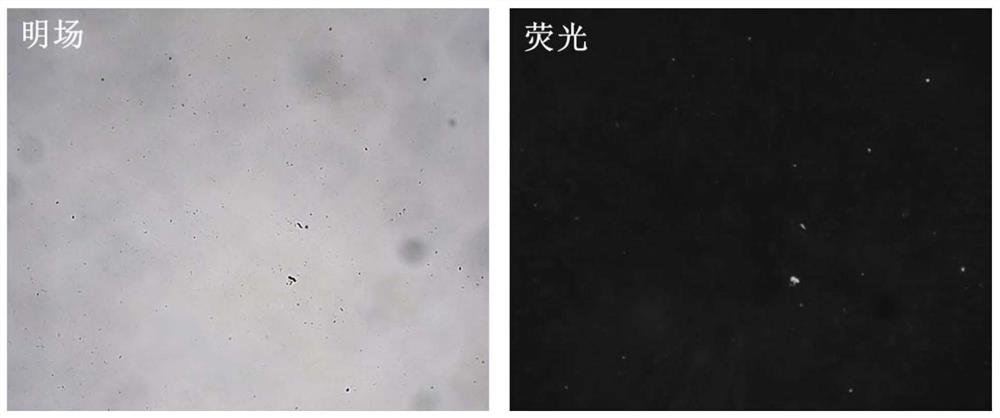Analysis method for identifying bacteria and testing antibiotic sensitivity in biological sample
A technology of biological samples and bacteria, which is applied in the preparation of test samples, material analysis, material analysis by electromagnetic means, etc., can solve the problems of low content of metabolites, small size of a single bacterium, and sensitivity that cannot reach the sensitivity of a single bacterium analysis, etc. , to achieve the effect of fast speed and high sensitivity
- Summary
- Abstract
- Description
- Claims
- Application Information
AI Technical Summary
Problems solved by technology
Method used
Image
Examples
Embodiment 1
[0065] The detection and identification of a single live bacterium in the whole blood of embodiment 1 comprises the following steps:
[0066] (1) Capture localization of bacteria in whole blood:
[0067] Take 1 mL of bacteria-infected whole blood in a centrifuge tube, centrifuge at 3,000 rpm for 8 min, discard the blood cell pellet, centrifuge 500 μL of the supernatant containing bacteria at 10,000 rpm for 8 min, discard the supernatant, resuspend the pellet in 100 μL of deionized water, add 10 μL of 100 μM Stain with Acridine Orange stain for 15 minutes, centrifuge the stained solution at 10,000 rpm for 8 minutes, wash away the stain, and resuspend the pellet in 100 μL deionized water. Drop the resuspended bacterial solution on the poly-lysine glass slide and let it stand for 30 minutes to allow the bacteria to adsorb and fix on the poly-lysine glass slide, rinse with deionized water, and dry the poly-lysine slide at room temperature. Slide, observe the position of the bacte...
Embodiment 2
[0082] The detection and identification of a single live bacterium in the cell of embodiment 2 bacterial infection, comprises the following steps:
[0083] (1) Separation of bacteria in cells:
[0084] Add 100 μL of 10% saponin to 1 mL of RAW264.7 cell suspension infected with bacteria, lyse at 37°C for 5 min, centrifuge at 3000 rpm for 8 min, discard the precipitate, and keep the supernatant containing bacteria.
[0085] (2) Capture location of bacteria:
[0086] Add 10 μL of 100 μM Acridine Orange stain to the bacterial solution obtained in step (1) for staining for 15 minutes, centrifuge the stained solution at 10,000 rpm for 8 minutes, wash away the stain, and resuspend the precipitate in 100 μL of deionized water. Drop the resuspended bacterial solution on the poly-lysine glass slide and let it stand for 30 minutes to allow the bacteria to adsorb and fix on the poly-lysine glass slide, rinse with deionized water, and dry the poly-lysine slide at room temperature. slides...
Embodiment 3
[0099] The detection and identification of a single live bacterium in the bacterial infection tissue of embodiment 3 comprises the following steps:
[0100] (1) Isolation of bacteria from infected tissue:
[0101] Wipe the infected tissue with a sterile cotton swab, put the swab into 1mL deionized water to elute the bacteria, and keep the eluate containing the bacteria.
[0102] (2) Capture location of bacteria:
[0103]Add 10 μL of 1 mM Acridine Orange stain to the bacterial solution obtained in step (1) for staining for 15 minutes, centrifuge the stained solution at 10,000 rpm for 8 minutes, wash off the stain, and resuspend the precipitate in 100 μL of deionized water. Drop the resuspended bacterial solution on the poly-lysine glass slide and let it stand for 30 minutes to allow the bacteria to adsorb and fix on the poly-lysine glass slide, rinse with deionized water, and dry the poly-lysine slide at room temperature. slides, and observe the location of the bacteria under...
PUM
 Login to View More
Login to View More Abstract
Description
Claims
Application Information
 Login to View More
Login to View More - R&D
- Intellectual Property
- Life Sciences
- Materials
- Tech Scout
- Unparalleled Data Quality
- Higher Quality Content
- 60% Fewer Hallucinations
Browse by: Latest US Patents, China's latest patents, Technical Efficacy Thesaurus, Application Domain, Technology Topic, Popular Technical Reports.
© 2025 PatSnap. All rights reserved.Legal|Privacy policy|Modern Slavery Act Transparency Statement|Sitemap|About US| Contact US: help@patsnap.com



